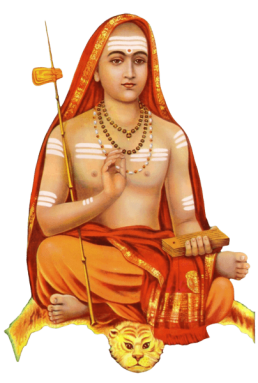ब्रह्मण्येव विलीनात्मा निर्विकारो विनिष्क्रियः ॥ ४२६ ॥
brahmaṇyeva vilīnātmā nirvikāro viniṣkriyaḥ || 426 ||
निर्विकल्पा च चिन्मात्रा वृत्तिः प्रज्ञेति कथ्यते
सुस्थितासौ भवेद्यस्य स्थितप्रज्ञः स उच्यते ॥ ४२७ ॥
nirvikalpā ca cinmātrā vṛttiḥ prajñeti kathyate
susthitāsau bhavedyasya sthitaprajñaḥ sa ucyate || 427 ||
प्रपञ्चो विस्मृतप्रायः स जीवन्मुक्त इष्यते ॥ ४२८ ॥
prapañco vismṛtaprāyaḥ sa jīvanmukta iṣyate || 428 ||
बोधो निर्वासनो यस्य स जीवन्मुक्त इष्यते ॥ ४२९ ॥
bodho nirvāsano yasya sa jīvanmukta iṣyate || 429 ||
Characteristics……waking state—that is, cognising the objective world through the senses, and being attached to it, like the ignorant man.
यस्य चित्तं विनिश्चिन्तं स जीवन्मुक्त इष्यते ॥ ४३0 ॥
yasya cittaṃ viniścintaṃ sa jīvanmukta iṣyate || 430 ||
Devoid of parts—as Brahman.
अहन्ताममताभावो जीवन्मुक्तस्य लक्षणम् ॥ ४३१ ॥
ahantāmamatābhāvo jīvanmuktasya lakṣaṇam || 431 ||
Shadow—See Sloka 413.
अउदासीन्यमपि प्राप्तं जीवन्मुक्तस्य लक्षणम् ॥ ४३२ ॥
audāsīnyamapi prāptaṃ jīvanmuktasya lakṣaṇam || 432 ||
सर्वत्र समदर्शित्वं जीवन्मुक्तस्य लक्षणम् ॥ ४३३ ॥
sarvatra samadarśitvaṃ jīvanmuktasya lakṣaṇam || 433 ||
Nature—preponderance of one or other of the. three Gunas.
उभयत्राविकारित्वं जीवन्मुक्तस्य लक्षणम् ॥ ४३४ ॥
ubhayatrāvikāritvaṃ jīvanmuktasya lakṣaṇam || 434 ||
अन्तर्बहिरविज्ञानं जीवन्मुक्तस्य लक्षणम् ॥ ४३५ ॥
antarbahiravijñānaṃ jīvanmuktasya lakṣaṇam || 435 ||
अउदासीन्येन यस्तिष्ठेत्स जीवन्मुक्तलक्षणः ॥ ४३६ ॥
audāsīnyena yastiṣṭhetsa jīvanmuktalakṣaṇaḥ || 436 ||
भवबन्धविनिर्मुक्तः स जीवन्मुक्तलक्षणः ॥ ४३७ ॥
bhavabandhavinirmuktaḥ sa jīvanmuktalakṣaṇaḥ || 437 ||
यस्य नो भवतः क्वापि स जीवन्मुक्त इष्यते ॥ ४३८ ॥
yasya no bhavataḥ kvāpi sa jīvanmukta iṣyate || 438 ||
प्रज्ञया यो विजानिति स जीवन्मुक्तलक्षणः ॥ ४३९ ॥
prajñayā yo vijāniti sa jīvanmuktalakṣaṇaḥ || 439 ||
समभावो भवेद्यस्य स जीवन्मुक्तलक्षणः ॥ ४४0 ॥
samabhāvo bhavedyasya sa jīvanmuktalakṣaṇaḥ || 440 ||
नदीप्रवाहा इव वारिराशौ ।
लिनन्ति सन्मात्रतया न विक्रियां
उत्पादयन्त्येष यतिर्विमुक्तः ॥ ४४१ ॥
nadīpravāhā iva vārirāśau |
linanti sanmātratayā na vikriyāṃ
utpādayantyeṣa yatirvimuktaḥ || 441 ||
अस्ति चेन्न स विज्ञातब्रह्मभावो बहिर्मुखः ॥ ४४२ ॥
asti cenna sa vijñātabrahmabhāvo bahirmukhaḥ || 442 ||
न सदेकत्वविज्ञानान्मन्दी भवति वासना ॥ ४४३ ॥
na sadekatvavijñānānmandī bhavati vāsanā || 443 ||
तथैव ब्रह्मणि ज्ञाते पूर्णानन्दे मनीषिणः ॥ ४४४ ॥
tathaiva brahmaṇi jñāte pūrṇānande manīṣiṇaḥ || 444 ||
ब्रवीति श्रुतिरेतस्य प्रारब्धं फलदर्शनात् ॥ ४४५ ॥
bravīti śrutiretasya prārabdhaṃ phaladarśanāt || 445 ||
Srutis .—The reference is to Chhandogya. Upanishad VI. xiv. 2, “Thedelay in his (i. e. a Jnanin’s) case is only so long as his body lasts,, after which, he becomes one with Brahmam”
Prârabdha work—is the work done in. past lives which has engendered the present body (referred to in Sloka 451). The other two kinds of work are the ‘Sanchita’ or accumulated (mentioned in Sloka 447) and the ‘Agámi’ or forthcoming (mentioned in Sloka 449).
Results .—the continuance of the body after realisation, and its experiences during that period can only be explained by assuming that the Prárabdha continues to work. This is further explained in the next Sloka.
Vivekachudamani – Introduction
1: Devoted Dedication
2: Glory of Spiritual Life
3: Unique Graces in Life
4-7: Miseries of The Unspiritual Man
8-13: Means of Wisdom
14-17: The Fit Student
18-30: The Four Qualifications
31: Bhakti – Firm and Deep
32-40: Courtesy of Approach and Questioning
41-47: Loving Advice of the Guru
48-49: Questions of the Disciple
50: Intelligent Disciple – Appreciated
51-55: Glory of Self-Effort
56-61: Knowledge of the Self-Its Beauty
62-66: Direct Experience – Liberation
67-71: Discussion on Questions Raised
72-75: Gross Body
76-82: Sense Objects a Trap – Man Bound
83-86: Fascination for Body Criticised
87-91: Gross Body Condemned
92: Organs of Perception and Action
93-94: Inner Instruments
95: The Five Pranas
96-101: Subtle Body – Effects
102: Functions of Prāna
103-105: Ego Discussed
106-107: Infinite Love – the Self
108-110: Māyā – Pointed Out
111-112: Rajoguņa – Nature and Effects
113-116: Tamoguņa – Nature and Effects
117-119: Sattvaguņa – Nature and Effects
120-121: The Causal Body – Its Nature
122-123: Not-Self – Description
124-135: The Self – Its Nature
136: Advice for Self-control
137-142: What is Bondage – The Reply
143-144: The Powers – Agitation and Veiling
145-146: Bondage in Action
147-153: Ātman and Anātman – Discrimination
Negation of the Kośas
154-164: – Annamaya kośa (Food sheath)
165-166: – Prņamaya kośa (Vital air sheath)
167-183: – Manomaya kosa (Mental sheath)
184-188: – Vijnanamaya kośa (Intellectual sheath)
189-191: Ātman – Unattached
192-193: What is Liberation? – Disciple
194-206: Self-Knowledge gives Liberation
207-210: Anandamaya kośa (Bliss sheath)
211: Ātman – Other than the Five Kośas
212: What is Ātman? – Disciple
213-225: Nature of the Self – Discussion
226-236: All Manifestation Absolute
237-240: Brahman – Its Nature
241-249: That Thou Art – Explanation
250-253: Attitude in Meditation
254-266: Aids to Meditation
267-276: Give up Vāsanās – the Method
277-292: End Superimposition – The Means
293-297: The Perceived I’ Factor – False
298-309: Condemnation of the Ego
310-319: Actions, Thoughts and Vāsanās – Renounce
320-329: Total Vigilance – Its Price
330-338: In the One, No Plurality
339-348: Spiritual Growth – the Secret
349-353: Cause-Effect – False
354-372: Samadhi – Its Nature
373-378: Fully Detached – Samadhi Easy
379-383: Meditation – the Technique
384-397: Continuous Attention to Self
398-406: No Diversity in Reality
407-413: Ātma-vicāra – Contemplation
414-418: Give up Perceptions
419-425: The Science of Reality – Its Benefits
426-445: Signs of a Realised Seer
446-464: Prārabdha for a Saint
465-471: There is No Plurality
472-479: Experience of Selfhood
480-520: Practice of Knowledge – Disciple
521-575: Final Words of Advice
576-578: Blessed Disciple Liberated
579-581: The Glory of the Textbook

Vivekachudamani – Verses 426-445 – Vivekachudamani Verses 426-445 – By Adi Sankaracharya – In Sanskrit with English Meaning, Transliteration, Translation, Commenary, Lyrics, Audio – Vivekachudamani-426-445
